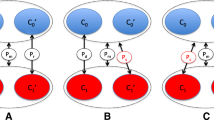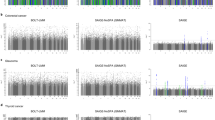Abstract
Sample size required for the TDT and the case-control designs was studied for marker-based genome-wide scans for disease association. The influence of various parameters on sample size required to attain a given level of power was analyzed in detail. Small genotypic relative risks, low levels of linkage disequilibrium, and departure from equal frequencies for the disease allele and associated marker allele, significantly and similarly increase sample size required by either the TDT or case-control design. Under the case-control paradigm, we show that the optimal strategy will often be to collect many more control individuals than disease cases with the optimal ratio depending on the relative cost of acquiring cases as compared to controls. For the TDT, the number of required simplex families is virtually equal to the number of cases required for similar power in case-control studies with an equal number of cases and controls. The case-control approach may therefore prove to be more economical and expeditious than the TDT design for diseases in which the cost and time required to collect simplex families is much greater than that needed to acquire isolated disease cases. Nevertheless, possible population stratification needs to be addressed when the case-control design is applied.
Similar content being viewed by others
REFERENCES
Abecasis, G. R., Noguchi, E., Heinzmann, A., Traherne, J. A., Bhattacharyya, S., Leaves, N. I., and Anderson, G. G. (2000). Extent and distribution of linkage disequilibrium in three genomic regions. Am. J. Hum. Genet. 68.
Abel, L., and Muller-Myhsok, B. (1998). Maximum-likelihood expression of the transmission/disequilibrium test and power considerations [letter]. Am. J. Hum. Genet. 63:664–667.
Arnheim, N., Strange, C., and Erlich, H. (1985). Use of pooled DNA samples to detect linkage disequilibrium of polymorphic restriction fragments and human disease: Studies of the HLA class II loci. Proc. Natl. Acad. Sci. USA 82:6970–6974.
Barcellos, L. F., Klitz, W., Field, L. L., Tobias, R., Bowcock, A. M., Wilson, R., and Nelson, M. P., et al. (1997). Association mapping of disease loci, by use of a pooled DNA genomic screen. Am. J. Hum. Genet. 61:734–747.
Boehnke, M., and Langefeld, C. D. (1998). Genetic association mapping based on discordant sib pairs: The discordant-alleles test. Am. J. Hum. Genet. 62:950–961.
Camp, N. J. (1997). Genomewide transmission/disequilibrium testing —Consideration of the genotypic relative risks at disease loci [see comments] [published erratum appears in Am. J. Hum. Genet. 1999 May;64(5):1485–1487]. Am. J. Hum. Genet. 61: 1424–1430.
Collins, A., Lonjou, C., and Morton, N. E. (1999). Genetic epidemiology of single-nucleotide polymorphisms [see comments]. Proc. Natl. Acad. Sci. USA 96:15173–15177.
Curtis, D. (1997). Use of siblings as controls in case-control association studies [published erratum appears in Ann. Hum. Genet. 1998 Jan;62(Pt 1):89]. Ann. Hum. Genet. 61:319–333.
Devlin, B., and Roeder, K. (1999). Genomic control for association studies. Biometrics 55:997–1004.
Goddard, K. A., Hopkins, P. J., Hall, J. M., and Witte, J. S. (2000). Linkage disequilibrium and allele-frequency distributions for 114 single-nucleotide polymorphisms in five populations. Am. J. Hum. Genet. 66:216–234.
Kruglyak, L. (1999). Prospects for whole-genome linkage disequilibrium mapping of common disease genes. Nat. Genet. 22: 139–144.
Lander, E., and Kruglyak, L. (1995). Genetic dissection of complex traits: Guidelines for interpreting and reporting linkage results [see comments]. Nat. Genet. 11:241–247.
Lewontin, R. C. (1988). On measures of gametic disequilibrium. Genetics 120:849–852.
McGinnis, R. (2000). General equations for Pt, Ps, and the power of the TDT and the affected-sib-pair test. Am. J. Hum. Genet. 67: 1340–1347.
McGinnis, R. E. (1998). Hidden linkage: A comparison of the affected sib pair (ASP) test and transmission/disequilibrium test (TDT). Ann. J. Hum. Genet. 62:159–179.
Moffatt, M. F., Traherne, J. A., Abecasis, G. R., and Cookson, W. O. (2000). Single nucleotide polymorphism and linkage disequilibrium within the TCR alpha/delta locus. Hum. Mol. Genet. 9:1011–1019.
Muller-Myhsok, B., and Abel, L. (1997). Genetic analysis of complex diseases [letter; comment]. Science 275:1328–1329; discussion 1329–1330.
Pritchard, J., and Rosenberg, N. (1999). Use of unlinked genetic markers to detect population stratification in association studies. Am. J. Hum. Genet. 65:220–228.
Reich, D., Cargill, M., Bolk, S., Ireland, J., Sabeti, P., Richter, D., Lavery, T., Kouyouinjian, R., Farhadian, S., Ward, R., and Lander, E. (2001). Linkage disequilibrium in the human genome. Nature 411:199–204.
Risch, N., and Merikangas, K. (1996). The future of genetic studies of complex human diseases [see comments]. Science 273:1516–1517.
Shifman, S., and Darvasi, A. (2001). The value of isolated populations. Nat. Genet. 28:309–310.
Slager, S., and Schaid, D. (2001). Evaluation of candidate genes in case-control studies: A statistical method to account for related subjects. Am. J. Hum. Genet. 68:1457–1462.
Spielman, R. S., and Ewens, W. J. (1998). A sibship test for linkage in the presence of association: the sib transmission /disequilibrium test. Am. J. Hum. Genet. 62:450–458.
Spielman, R. S., McGinnis, R. E., and Ewens, W. J. (1993). Transmission test for linkage disequilibrium: The insulin gene region and insulin-dependent diabetes mellitus (IDDM). Am. J. Hum. Genet. 52:506–516.
Taillon-Miller, P., Bauer-Sardina, I., Saccone, N. L., Putzel, J., Laitinen, T., Cao, A., and Kere, J. (2000). Juxtaposed regions of extensive and minimal linkage disequilibrium in human Xq25 and Xq28 [see comments]. Nat. Genet. 25:324–328.
Tu, I. P., and Whittemore, A. S., (1999). Power of association and linkage tests when the disease alleles are unobserved. Am. J. Hum. Genet. 64:641–649.
Xiong, M., and Guo, S. W. (1998). The power of linkage detection by the transmission/disequilibrium tests. Hum. Hered. 48: 295–312.
Author information
Authors and Affiliations
Corresponding author
Rights and permissions
About this article
Cite this article
McGinnis, R., Shifman, S. & Darvasi, A. Power and Efficiency of the TDT and Case-Control Design for Association Scans. Behav Genet 32, 135–144 (2002). https://doi.org/10.1023/A:1015205924326
Issue Date:
DOI: https://doi.org/10.1023/A:1015205924326




